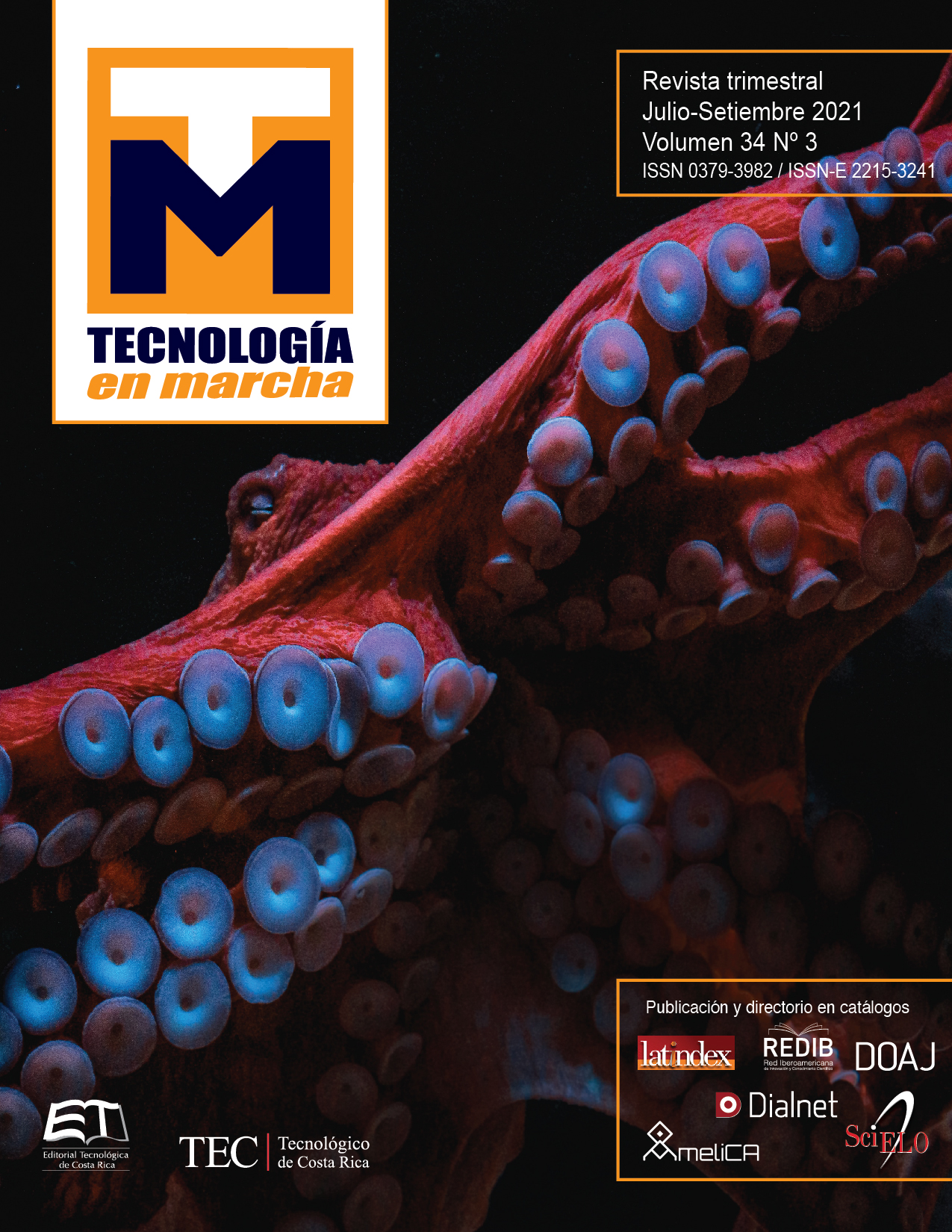Life cycle analysis of lettuce (Lactuca sativa) cultivated under an organic and conventional management system, as input for decision-making in two Costa Rican agricultural farms
Main Article Content
Abstract
The potential environmental and economic risks of an organic and a conventional lettuce production system were evaluated and compared through a Life Cycle Analysis (LCA) and Life Cycle Cost (LCC). The kilogram of lettuce was defined as a functional unit, for a productive process with established limits between the acquisition of inputs (cradle) and transport to the commercialization (gate). Based on the findings, a multicriteria decision method known as Analytic Hierarchy Process was applied to prioritize factors of interest and the system of preference in the context under study. The main results are that the conventional system presented increased environmental impact in comparison with the organic system for indicators of global warming potential in 13%, eutrophication in 85%, acidifying gases in 62% and deterioration of the ozone layer risk in 96%. As for the LCC, the costs were higher in the organic system for the pre-production stages by 45%, production by 13% and commercialization by 32%. While in conditioning, the cost was 9,1% greater for the conventional system. It is concluded that management practices with environmental and economic potential should be oriented to aspects such as efficient use of transport, use of bio-inputs, recycling, wastewater treatment, plant waste management and participation in environmental programs and it is recommended that practices decrease focus on the stages where the greatest impacts and costs were found.
Article Details

This work is licensed under a Creative Commons Attribution-NonCommercial-NoDerivatives 4.0 International License.
Los autores conservan los derechos de autor y ceden a la revista el derecho de la primera publicación y pueda editarlo, reproducirlo, distribuirlo, exhibirlo y comunicarlo en el país y en el extranjero mediante medios impresos y electrónicos. Asimismo, asumen el compromiso sobre cualquier litigio o reclamación relacionada con derechos de propiedad intelectual, exonerando de responsabilidad a la Editorial Tecnológica de Costa Rica. Además, se establece que los autores pueden realizar otros acuerdos contractuales independientes y adicionales para la distribución no exclusiva de la versión del artículo publicado en esta revista (p. ej., incluirlo en un repositorio institucional o publicarlo en un libro) siempre que indiquen claramente que el trabajo se publicó por primera vez en esta revista.
References
BBC News Mundo . (23 de Mayo de 2019). Ozone layer: Banned CFCs traced to China say scientists. BBC News Mundo .
Contreras, E. (2014). Aplicación del Análisis de ciclo de vida del producto (ACV) en la cadena productiva del cacao como estrategia de ventaja competitiva ambientalmente sostenible . Obtenido de Universidad Piloto de Colombia : http://polux.unipiloto.edu.co:8080/00001232.pdf
El Financiero . (22 de julio de 2016). ¿Cómo son los agricultores en cada provincia de Costa Rica? Obtenido de El financiero : https://www.elfinancierocr.com/gnfactory/ELF/GNF/2016/07/22/0001/agricultura-organiza-costa-rica-agricultores_19_998490142.html
Gobierno de la República de Costa Rica. (2017). Objetivos de desarollo sostenible. Obtenido de Gobierno de la República de Costa Rica: http://www.ods.cr/pacto-nacional
Hunkeler , D., Lichtenvort, K., & Rebitzer, G. (2015). Enviromental life cycle costing . New York: SETAC.
Hurtado, G. (2013). Universidad Nacional Mayor de San Marcos. Obtenido de Proceso de análisis Jeárquico (AHP): http://sisbib.unmsm.edu.pe/bibvirtualdata/Tesis/Basic/toskano_hg/cap3.PDF
Instituto Nacional de Estadística y Censos. (2014). Censo Nacional Agropecuario. Obtenido de Instituto Nacional de Estadística y Censos: http://www.inec.go.cr/censos/censo-agropecuario-2014
INTECO. (2007). Análisis de ciclo de vida: INTE/ISO 14040: 2007. Obtenido de INTECO.
Lassaletta, L., & Rovira, J. (2011). Influencia de la agricultura industrial en el cambio global. El Ecologista, 23-26.
Marín , J., & Gonzáles, E. (s.f.). El futuro de los combustibles fósiles. Obtenido de Universidad Nacional de Educación a Distancia: https://canal.uned.es/uploads/materials/resources/pdf/4/1/1319025174814.pdf
Ministerio Para la Transición Ecológica (MITECO). (2016). Problemática ambiental y contaminantes. Obtenido de MITECO: https://www.miteco.gob.es/es/calidad-y-evaluacion-ambiental/temas/atmosfera-y-calidad-del-aire/emisiones/prob-amb/
Ortiz , O., Villamizar , R., & Rangel , J. (2014). Applying life cycle management of colombian cocoa production. Obtenido de Scielo : http://www.scielo.br/scielo.php?script=sci_arttext&pid=S0101-20612014000100009
Programa Integral de Mercadeo Agropecuario (PIMA) . (Noviembre de 2016). Análisis del consumo de frutas,hortalizas,pescado y mariscos en los hogares costarricenses. Obtenido de Programa Integral de Mercadeo Agropecuario (PIMA) : https://mail.google.com/mail/u/0/#search/pima+analisisn/MfcgxmSfCnjdQRfsNQdgLjvjtQXRTDs?compose=CllgCJqVNfGJqXvqjRnjddtXpSPzmJclkXcVrLMfzChcJBnBzQqjBvsPrkHCQrbdftvtTBmjtlq&projector=1
Saaty, T. (2008). Decision making with the analytic hierarchy process. Obtenido de Services : http://www.rafikulislam.com/uploads/resourses/197245512559a37aadea6d.pdf
Secretaría Ejecutiva de Planificación Sectorial Agropecuaria (SEPSA). (2014). Situación y desafíos de la agricultura costarricense. Obtenido de Secretaría Ejecutiva de Planificación Sectorial Agropecuaria (SEPSA): http://www.sepsa.go.cr/PRODUCTOS/2014_Diagn%C3%B3stico%20Sector%20Agropecuario%202009-2012.pdf
Suchini, G. (2012). Innovaciones agroecológicas para una producción agropecuaria sostenible en la Región de Trifinio. Obtenido de CATIE: http://www.infoiarna.org.gt/rediarna/2012/Red%20IARNA%2029%20(03)/adjuntos/Innovaciones-agroecologicas-CATIE.pdf
Vanegas, M. P. (2006). Efecto de los sistemas agroforestales de café orgánico y convencional sobre las carac terísticas de suelos en el Corredor Biológico Turrialba–Jiménez, Costa Rica . Obtenido de Centro Agronomico Tropical de Investigación y Enseñanza Tropical: http://repositorio.bibliotecaorton.catie.ac.cr/bitstream/handle/11554/4881/Efecto_de_los_sistemas_agroforestales_de_cafe_organico.pdf;jsessionid=4D43F60A9467743D9D0E8D2789613B5B?sequence=1

